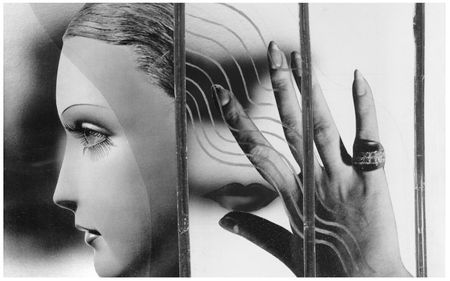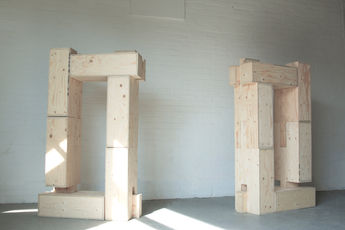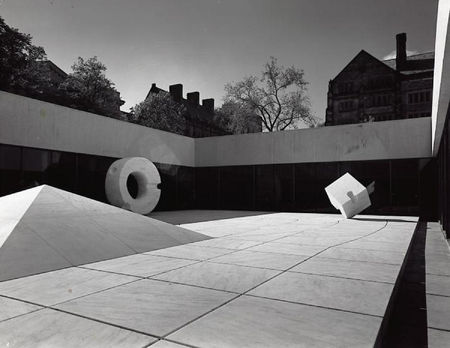Modernism
Modernism refers to a global movement in society and culture that from the early decades of the twentieth century sought a new alignment with the experience and values of modern industrial life. Building on late nineteenth-century precedents, artists around the world used new imagery, materials and techniques to create artworks that they felt better reflected the realities and hopes of modern societies.
By the 1960s modernism had become a dominant idea of art, and a particularly narrow theory of modernist painting had been formulated by the highly influential American critic Clement Greenberg. A reaction then took place which was quickly identified as postmodernism.
The birth of modernism and modern art can be traced to the Industrial Revolution.Before the 19th century, artists were most often commissioned to make artwork by wealthy patrons or institutions like the church. Much of this art depicted religious or mythological scenes that told stories intended to instruct the viewer. During the 19th century, many artists started to make art based on their own, personal experiences and about topics that they chose. With the publication of psychologist Sigmund Freud’s The Interpretation of Dreams (1899) and the popularization of the idea of a subconscious mind, many artists began exploring dreams, symbolism, and personal iconography as avenues for the depiction of their subjective experiences. Challenging the notion that art must realistically depict the world, some artists experimented with the expressive use of color, non-traditional materials, and new techniques and mediums.

Jean Arp
Cubism and Dadaism

For Dada artists, the aesthetic of their work was considered secondary to the ideas it conveyed. “For us, art is not an end in itself,” wrote Dada poet Hugo Ball, “but it is an opportunity for the true perception and criticism of the times we live in.” Dadaists both embraced and critiqued modernity, imbuing their works with references to the technologies, newspapers, films, and advertisements that increasingly defined contemporary life.
They were also experimental, provocatively re-imagining what art and art making could be. Using unorthodox materials and chance-based procedures, they infused their work with spontaneity and irreverence. Wielding scissors and glue, Dada artists innovated with collage and photomontage. Still others explored games, experimental theater, and performance. A central figure, Marcel Duchamp, declared common, manufactured goods to be “readymade” artworks, radically challenging the notion of a work of art as something beautiful made by a technically skilled artist.
Automatism
In art, automatism refers to creating art without conscious thought, accessing material from the unconscious mind as part of the creative process.
Freud’s ideas strongly influenced French poet André Breton who launched the surrealist movement in 1924 with the publication of the Manifesto of Surrealism. In the manifesto, Breton defined surrealism as
‘Pure psychic automatism ... the dictation of thought in the absence of all control exercised by reason and outside all moral or aesthetic concerns’.
Breton and others produced the earliest examples of automatism in their automatic writings, aiming to write as rapidly as possible without intervening consciously to guide the hand.
Carl Andre
Minimalism

"The world is my studio". He is not a studio artist, he is a location artist. he works where he is going to have the show or the exhibition. When he first started he did make drawings and sketching, but he found out when he arrived at the place where he was going to make the show or the gallery, then he had to rip off the drawings anyway. So rather than trying to recreate what you had imagined in the studio, you much rather go to the place and react or act with the materials and the location where it is. Work of art don’t mean anything, they are realities. What does reality mean? It’s there.
Because our culture tends to turn everything into language we lose sight of the actual being of things.
He had a major discovery early on in his career when he realise thtt all he needed to do was to observe the materials and place them in a space that he realised that he didn’t need to touch, interfere the material. Instead operated from an idea that he’s displaying matter in space and in that combination of both the restraint and also the embrace of the material as it was being manufactured. He gathered materials from supplied that are about to become something. Take an organic material to transform it into a unit that can be then mobilised to create sth else. It is an encounter with a production that is taking place in society in order to generate capital and it is an interruption of that process somehow the work take u into a place where u have to reflect of the hand of that worker so even tho his own hands r not involved we are thinking of his invisible worker that is at the factory behind his work. It is really a fascinating discovery for us it’s a physical work. You have almost to make a performance to install it u have to lay down on the ground or bend to kneel to place it.
Polam Chan

Art & design mentioned continuously in the same genre, but both are distinctive from the process of thinking and building. Polam's work intends to combine both his artistic process and his curiosity in architecture to create an artwork that able to resonate audiences to the current society’s housing design and craft. Moreover, he has an interest in how viewers interact with the “bricks.”
Constructing houses and architecture are getting more accessible than ever. By creating the “bricks” by hand, one by one from designing, measurement to forming, and making. It showcases the contrast between human-made & machine-made articles in architecture/ society. The purpose of 1000-385- 200 is to let the audience to investigate a unique kind of structure; reacting to technology affects us in countless ways in our everyday life. Lastly, expressing my enthusiasm for the blend of art and design sculpture.
Oskar Schlemmer
Bauhaus

The Bauhaus teaching method replaced the traditional pupil-teacher relationship with the idea of a community of artists working together. Its aim was to bring art back into contact with everyday life, and architecture, performing arts, design and applied arts were therefore given as much weight as fine art. The name is a combination of the German words for building (bau) and house (haus) and may have been intended to evoke the idea of a guild or fraternity working to build a new society. Teachers included Wassily Kandinsky, Paul Klee, László Moholy-Nagy and Josef Albers.
As his career matured in tandem with Gropius’ Bauhaus - Schlemmer turned his attention to the stage; teaching classes that synergized kinetic motion studies, figurative illustration and philosophy. Art’s intimate interrelation with the human body - its relationship to space and its affiliation to design and architecture - were always the jumping off points for Schlemmer’s creative process. He once stated that, “the history of theatre is the history of the transformation of human body. This elemental obsession with the “Der Mensch” and its movement defined Schlemmer’s most enduring works. Describing his output, considered by many as the genesis of ‘multimedia,’ he once stated: “My themes – the human figure in space, its moving and stationary functions, sitting, lying, walking, standing – are as simple as they are universally valid.”
Moholy Nagy
Bauhaus

László Moholy-Nagy
He was highly influenced by constructivism and a strong advocate of the integration of technology and industry into the arts. He was called "relentlessly experimental" because of his pioneering work in painting, drawing, photography, collage, sculpture, film, theater, and writing. He later delved into various fields, from commercial design to theater set design, and also made films and worked as a magazine art director by combining photography with typography to create what he called the typo-photo, Moholy-Nagy is considered by many to be the initializer of modern graphic design.
“There must be no antagonism between architecture and its natural setting,”.A drawing of a tree growing through a building was to illustrate that “the architecture of the house embraces the garden. House and garden coalesce, a single unit in the landscape”.
Bauhaus design came to reconcile the artificial and the natural in a way that would both enhance human life potentials and create a harmonious environment. Moholy-Nagy was pursuing an indirect argument for ecological protection, namely that a well-functioning biotic community was a precondition for a well-functioning human society. “The new architecture on its highest plane will be called upon to remove the old conflict between organic and artificial, between open and closed, between country and city,” he told British architects.
A19 painting:
Moholy-Nagy had mixed feelings about painting as a medium, sensing that the notion of individual creativity that it represented was being superseded in the machine age, and that the creative spirit needed to find a new way of interacting with and accepting the mechanical and the robotic in their work. Yet he remained engaged with developments in "fine art" going on around him, including the advent of Constructivism and De Stijl by the early 1920s.
Isamu Noguchi
Biomorphic

1- The abstract Void sculptures, Noguchi emphasized the importance of negative space in sculpture by drawing on Zen Buddhist concepts of emptiness. He also found inspiration in laws of physics referring to the cyclical energy flow through all matter, seen here in the piece's continual loop. The piece neither begins nor ends, but rather suggests the timeless flow of energy and of life itself.
2- Noguchi first encountered Japanese gardens during his visits to his father's birth land in the 1930s. By the 1950s he began to design his own unique gardens. The designed garden became a crucial concept for his sculptural landscapes, which he saw as a means to integrate art into social environments. He viewed his work as a "sculpture of spaces," rather than a collection of discrete pieces. Jardin Japonais, for UNESCO headquarters in Paris, was his first major landscape commission. Noguchi felt that gardens should be experienced as nature untouched, so he included elements such as overall organic shapes and lanterns made of natural stone. He arranged the carefully selected Japanese stones by drawing on both Japanese tradition and his own unique design, fusing his skill as a designer with his high regard for the natural world. The fact that Noguchi's patron was the United Nations for a French location speaks to the international reputation, and high regard for the artist and his ability to represent the highest ideals of this international entity.n/a - UNESCO Headquarters, Paris, France
In terms of negative space, we should discuss about Saihoji - the Moss temple in Japan. By the time the garden opens, a few of visitors have gathered and they are guided into the temple to chant with the monks. Only after this ritual has been performed are you allowed to move into the garden. It is a beautiful thing to be made to pause in this way, preparing you for the gentle rhythms of sensors immersion that lie ahead as you move around the lakes, observing the undulating texture of the moss and the different scales of the arrangements of tree and rocks, the garden demands a slowing down. In Japanese gardens, the charge between each element causes us to stay silent, and in silence, all possibilities are born. the space between the obj is what reveals the true spirit of the garden. As we move around, we become part of this subtle dialogue that heightens our sensibilities and self-awareness and, as it does so, make us part of the composition. Noguchi stated:" If the sculpture is the rock, it is also the space betweenrocks and between the rock and a man, and the communication and contemplation between"
































